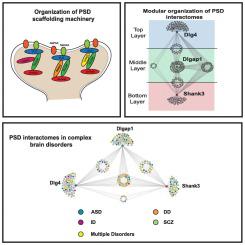Cellular Signalling ( IF 4.8 ) Pub Date : 2020-09-14 , DOI: 10.1016/j.cellsig.2020.109782 Brent Wilkinson 1 , Marcelo P Coba 2

|
The postsynaptic density (PSD) plays an essential role in the organization of the synaptic signaling machinery. It contains a set of core scaffolding proteins that provide the backbone to PSD protein-protein interaction networks (PINs). These core scaffolding proteins can be seen as three principal layers classified by protein family, with DLG proteins being at the top, SHANKs along the bottom, and DLGAPs connecting the two layers. Early studies utilizing yeast two hybrid enabled the identification of direct protein-protein interactions (PPIs) within the multiple layers of scaffolding proteins. More recently, mass-spectrometry has allowed the characterization of whole interactomes within the PSD. This expansion of knowledge has further solidified the centrality of core scaffolding family members within synaptic PINs and provided context for their role in neuronal development and synaptic function. Here, we discuss the scaffolding machinery of the PSD, their essential functions in the organization of synaptic PINs, along with their relationship to neuronal processes found to be impaired in complex brain disorders.
中文翻译:

突触后相互作用组的分子结构。
突触后密度 (PSD) 在突触信号机制的组织中起着至关重要的作用。它包含一组核心支架蛋白,为 PSD 蛋白质-蛋白质相互作用网络 (PIN) 提供主干。这些核心支架蛋白可以被视为按蛋白质家族分类的三个主要层,DLG 蛋白在顶部,SHANK 位于底部,DLGAP 连接两层。利用酵母二杂交体的早期研究能够鉴定多层支架蛋白内的直接蛋白质-蛋白质相互作用 (PPI)。最近,质谱法允许表征 PSD 内的整个相互作用组。这种知识的扩展进一步巩固了核心支架家族成员在突触 PIN 中的中心地位,并为其在神经元发育和突触功能中的作用提供了背景。在这里,我们讨论 PSD 的支架机制、它们在组织突触 PIN 中的基本功能,以及它们与发现在复杂脑部疾病中受损的神经元过程的关系。


























 京公网安备 11010802027423号
京公网安备 11010802027423号